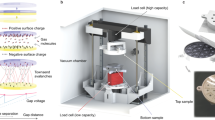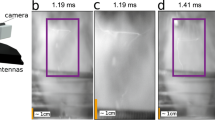Abstract
INVESTIGATIONS of the conditions for ignition of inflammable gas by electrical sparking have usually been carried out with discharges produced in one of two ways: (i) by discharging a capacitor charged to a high voltage between thin fixed electrodes separated by several millimetres; (ii) by breaking low-voltage circuits at the contacts of a mechanical switch (or ‘break-flash’). It has been found that less electrical energy need be dissipated in the discharge to ignite the gas if the first of these methods is adopted; for example, an 8.3 per cent mixture of methane in air can be ignited by about 0.3 mJ. by the first method, whereas an energy of about 2 mJ. is required if the second method is used.
This is a preview of subscription content, access via your institution
Access options
Subscribe to this journal
Receive 51 print issues and online access
$199.00 per year
only $3.90 per issue
Buy this article
- Purchase on SpringerLink
- Instant access to full article PDF
Prices may be subject to local taxes which are calculated during checkout
Similar content being viewed by others
References
Lloyd, H., and Guénault, E. M., Safety in Mines Res. Estab. Res. Rep., No. 33 (1951).
Berz, I., Combustion and Flame Quarterly, 3, 131 (1959).
Lintin, D. R., and Wooding, E. R., Brit. J. App. Phys., 10, 159 (1959).
Gavril'chenko, L. I., Voprosy Gornoi Electromekhaniki, Trudy Mak NII. Ugletekhizdat. M., 9, 94 (1959).
Author information
Authors and Affiliations
Rights and permissions
About this article
Cite this article
GORDON, R., LORD, H. & WIDGINTON, D. Ignition of Gas by Sparks produced by breaking Wires at High Speed. Nature 191, 1085–1086 (1961). https://doi.org/10.1038/1911085a0
Issue date:
DOI: https://doi.org/10.1038/1911085a0
This article is cited by
-
Study of electron density in the ionosphere through ground reception of radio signals from space vehicles (survey)
Radiophysics and Quantum Electronics (1968)



